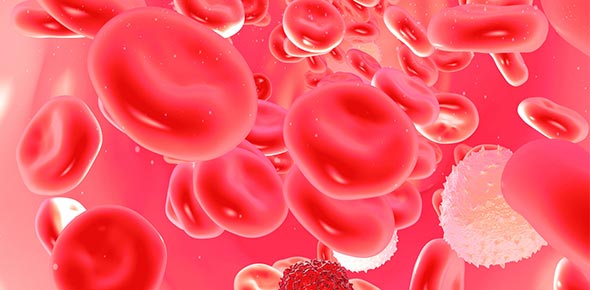Immunology!

- 1.
Which of the following is part of the body's "first line of defense" against disease?
- A.
Macrophages
- B.
Skin
- C.
T lymphocytes
- D.
Antibodies
Correct Answer
B. SkinExplanation
Cellular defenses, even generalized ones like macrophages, help to protect the body after a pathogen has invaded. Skin and mucous membranes block entry of pathogens.Rate this question:
-
- 2.
What is a substance that a person can produce antibodies against?
- A.
Antigen
- B.
Antibull
- C.
Complement
- D.
Macrophage
Correct Answer
A. Antigen -
- 3.
What cells destroy pathogens by engulfing them?
- A.
Cytotoxic T Cells
- B.
Basophils
- C.
Eosinophils
- D.
Macrophages
Correct Answer
D. Macrophages -
- 4.
What type of cell produces antibodies?
- A.
Macrophages
- B.
Neutrophils
- C.
Plasma B lymphocytes
- D.
Memory T lymphocytes
Correct Answer
C. Plasma B lymphocytes -
- 5.
Which type of cell destroys body cells that have been overwhelmed by infection?
- A.
Cytotoxic T cells
- B.
Memory T cells
- C.
Plasma B cells
- D.
Memory B cells
Correct Answer
A. Cytotoxic T cells -
- 6.
HIV compromises the immune system by invading which cells?
- A.
Cytotoxic T cells
- B.
Helper T cells
- C.
Helper B cells
- D.
Plasma B cells
Correct Answer
B. Helper T cells -
- 7.
Monoclonal antibodies are produced by
- A.
Recombinant DNA methods
- B.
Clones of memory cells
- C.
Hybridoma cell cultures
- D.
Cytokines
Correct Answer
C. Hybridoma cell cultures -
- 8.
Which of the following are reasons why antibiotics are effective against bacteria, but not viruses? Check all that apply.
- A.
Antibiotics can block metabolic pathways that are present in bacteria.
- B.
Antibiotics can block bacterial protein synthesis.
- C.
Viruses use the host cell metabolic pathways.
- D.
Viruses do not have cell walls.
- E.
Viruses have vastly different genetic material than bacteria.
Correct Answer(s)
A. Antibiotics can block metabolic pathways that are present in bacteria.
B. Antibiotics can block bacterial protein synthesis.
C. Viruses use the host cell metabolic pathways.
D. Viruses do not have cell walls. -
- 9.
The first step in destruction of a pathogen by a phagocytic leucocyte is engulfing the pathogen.
- A.
True
- B.
False
Correct Answer
B. FalseExplanation
The first step is chemical recognition of the pathogen.Rate this question:
-
- 10.
A ____________ is an organism or virus that can cause disease or an immune response.
Correct Answer
pathogen - 11.
A macrophage that has engulfed an antigen will bind to and activate helper T cells, which bind to and activate B cells.
- A.
True
- B.
False
Correct Answer
A. True -
- 12.
Once the body has been exposed to a particular antigen, __________ will be able to recognize the antigen in the future and clone rapidly to produce an "army" of antibody-producing cells against that antigen.
Correct Answer
Memory B cell
Memory B lymphocyte
Memory cell - 13.
HIV is a
- A.
Bacterium
- B.
Retrovirus
- C.
Modernovirus
- D.
Fungus
Correct Answer
B. Retrovirus -
- 14.
Check the ways in which HIV/AIDS can be transmitted.
- A.
Breastmilk
- B.
Bodily fluids
- C.
Semen
- D.
Vaginal secretions
- E.
Saliva
- F.
Sharing needles
- G.
Blood transfusions in the 1980s
- H.
Hugging
- I.
Using the same toilet as an infected person
Correct Answer(s)
A. Breastmilk
B. Bodily fluids
C. Semen
D. Vaginal secretions
F. Sharing needles
G. Blood transfusions in the 1980s -
- 15.
Place these steps involved in clotting in the correct order.
- A.
Thrombin ---> Prothrombin ---> Fibrin ---> Fibrinogen
- B.
Prothrombim ---> Thrombin ---> Fibrinogen ---> Fibrin
- C.
Fibrin ---> Fibrinogen ---> Prothrombin ---> Thrombin
- D.
Prothrombin ---> Thrombin ---> Fibrin ---> Fibrinogen
- E.
Eat more carrots ---> Eat even more ---> turn into a bunny
Correct Answer
B. Prothrombim ---> Thrombin ---> Fibrinogen ---> Fibrin -
- 16.
The colostrum provides passive immunity.
- A.
True
- B.
False
Correct Answer
A. True -
- 17.
Vaccines are a form of passive immunity.
- A.
True
- B.
False
Correct Answer
B. False -
Quiz Review Timeline +
Our quizzes are rigorously reviewed, monitored and continuously updated by our expert board to maintain accuracy, relevance, and timeliness.
-
Current Version
-
Nov 18, 2011Quiz Edited by
ProProfs Editorial Team -
Nov 17, 2011Quiz Created by
Rogersbths
- Anatomy Quizzes
- Bacteria Quizzes
- Bio Quizzes
- Biological Evolution Quizzes
- Biology Exam Quizzes
- Biology Test Quizzes
- Cell Quizzes
- Cell Biology Quizzes
- Chapters Of Biology Quizzes
- Classical Conditioning Quizzes
- Conservation Biology Quizzes
- Enzyme Quizzes
- Fungi Quizzes
- General Biology Quizzes
- Genetics Quizzes
- Macromolecule Quizzes
- Marine Biology Quizzes
- Microbiology Quizzes
- Mitosis And Meiosis Quizzes
- Molecular Biology Quizzes
- Parasitology Quizzes
- Physiology Quizzes
- Prokaryote Quizzes
- Protist And Fungi Quizzes
- Protozoa Quizzes
- Respiratory Quizzes
- Spine Quizzes
- Stem Cell Quizzes
- Taxonomy Quizzes
- Traits Quizzes
- Ultimate Biology Quizzes
- Virus Quizzes
- Zoology Quizzes
 Back to top
Back to top


